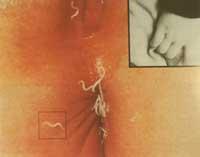Parasites of childhood
Sarna or sarna
Sarna or sarna is a cutaneous disease caused by an arthropod called sarcoptes scabis.
This mite, in the epidermis, makes a channel (1 mm wide and 3-5 mm long) and at its end or end it lays its eggs. From the eggs leave the larvae which then become nymphs. These nymphs, from the old ditch, create a new gallery or extend outside to create new lines or ditches. While the females remain inside the gallery, the males go to the skin in search of new females.

Formerly it was mixed with eczema and prurigo. Renucci was a rough student, at the University, who publicly showed her mite, doing with a needle the same as the women of her village had taught her to go under the line. For this it is necessary to break the vault or canalon vault and remove a claw of tip. The mite is then viewed under a microscope, with all its details.
The most typical and typical lesions are stretch marks (direct or sinuous). On the skin they create a kind of fool and appear mainly in the interdigital folds, wrists, joint folds, etc. In children, the palms of the hands, the ointzoles and even the face are usually attacked.
The skin has a wide variety of lesions around the canalons: caused by allergic reactions, or coming from deposition or infection.
These lesions appear within 10 days of contamination.
This disease produces enormous growth. Today, less is observed when improving the hygiene of people (and children). The disease is transmitted directly from the sick person to those who live with it, or through sheets, blankets, towels, etc.
It is a disease that occurs in all countries and in all ages.
The treatment (and healing by the way) is achieved by rubbing the body with proper liquid, while a careful cleaning of the bathrooms and the clothes and interior beds is done.
Intestinal worms
There can be many and very different intestinal worms: GIARDIA LAMBLIA, OXIUROS, etc.
They are more widespread diseases than people believe. Although the different investigations have different consequences, in all of them the parasite rates are very high. However, and in general terms, the prevalence of these infections is minimal in children under 2 years, while in school children (5-16 years) the maximum drop in adults to rise again in the elderly.
* Intestinal lamblía or lamblía Giardia
These worms are not seen at first sight, like other intestinal worms.
The main symptom of this disease is diarrhea. They usually last a few days, along with vomiting and abdominal pain, and if after treatment has been adequate, the situation is normalized. But many times healing is not complete or the child is contagious again (because the environment is not healthy enough, as the nursery environment. ). In these cases the disease can become chronic and the severity will be greater. Therefore, the cleaning measures should be extreme.
* Oxyuriasis ( Enterobius vermicularis )
The EV is a circular worm, yellowish white, well visible to the naked eye (the male measures 9-12 mm, 3-5 mm females).
Ripe worms are placed in the last parts of the funnel (blind and esophagus), where the starter occurs. When the uterus of the worms is filled with eggs (from 8,000 to 12,000 eggs), they are directed toward the rectum, either with stools or on their own. The anal sphincter is violated and leaves outside. These movements occur at night and cause a great itching.
Outside the intestine the female finds the right conditions and lays the eggs. Normally, although sometimes the anal sphincter is crossed inward, the worm dies, since its life cycle is 37-53 days.
Oxyuriasis is very contagious, since the parasite person removes thousands of eggs dispersed between their clothes, personal objects and soil.
Autoinfestation is very frequent: in the area of ??the ass is finger, without taking the proper cleaning measures and then (especially in children) the fingers rebounded lead to the mouth.
Generally light symptomatology. This pruritus or itching (can be very hard), lesions of the lump of worms in the skin and also lesions in the form of eczema. Apparently, loss of sleep, restlessness, nervousness, irritability, personality changes would occur on the nervous system. Bad localized pains can also appear, mainly in the right hole under ribs, and diarrhea.
The diagnosis is made by identifying the eggs. Eggs appear in very rare cases in stool, so STOOL ANALYSIS IS NOT USEFUL IN 95% OF CASES. For this purpose, a transparent or transparent adhesive tape is placed at the end of a depressor, placing the adhesive part outward. In the morning, before unmasking and cleaning, the buttocks are separated and the eggs are compressed with the depressor.
The proper treatment is done by drugs. It should be repeated at 15 days.
Other measures to be adopted are:
- Use narrow pyjamas without holes.
- Frequent cleaning of underwear, towels, sheets and hot water.
- Frequent hand washing (especially before eating).
- Careful preparation and cleaning of foods to be eaten raw (fruits, vegetables).
It is a measure that must never be forgotten, once diagnosed a person with oxyuriasis, to analyze and control all other family members.





